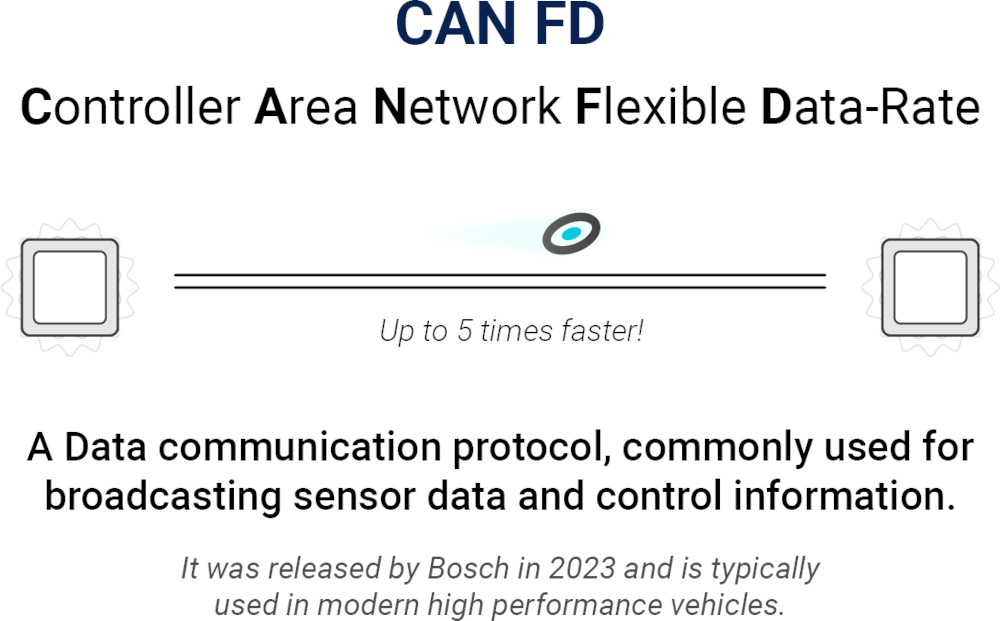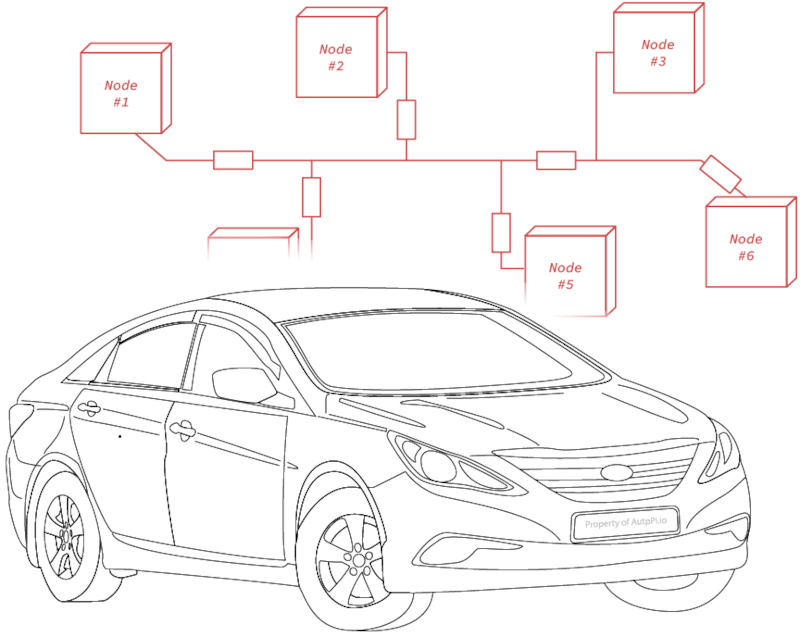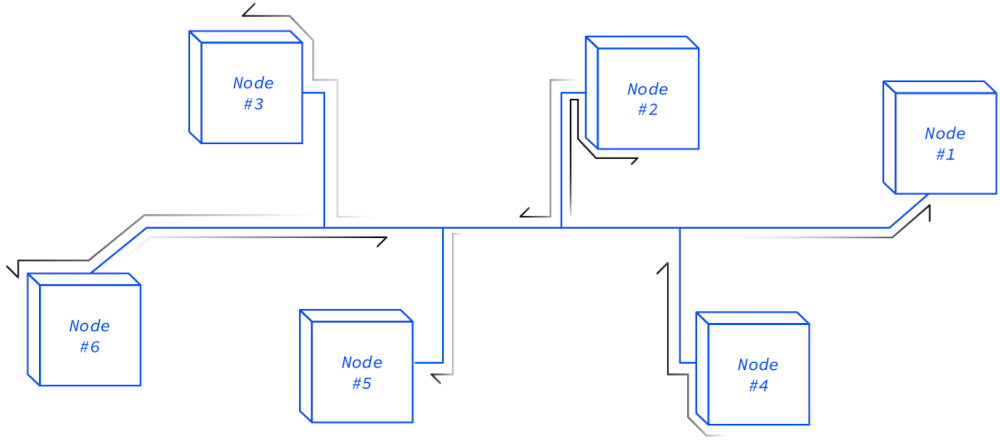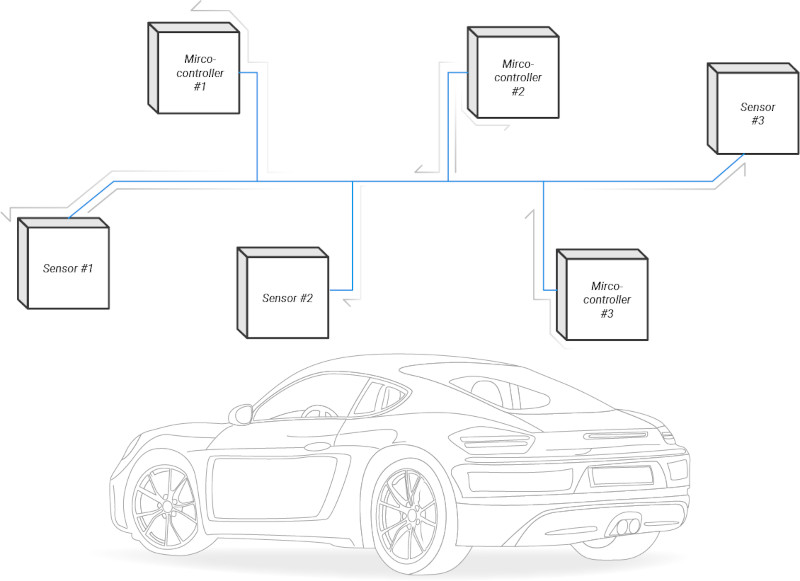If you’ve ever tried streaming HD video over dial-up, you know how sluggish CAN can feel. Controller Area Network with Flexible Data-Rate (CAN FD) is the high-speed upgrade: designed to carry more data, faster, and with greater reliability ([autopi.io][1]).
CAN FD boosts transfer rates up to 8 Mbps, eight times faster than classic CAN, and expands payload capacity from 8 to 64 bytes per frame. It’s built to integrate seamlessly with existing CAN networks, so you get a smoother upgrade without overhauling your infrastructure.
On top of that, CAN FD adds advanced CRC checks and error flags for robust data integrity, plus dynamic bit-rate switching to prioritize urgent messages. In short, it’s the protocol that keeps your system responsive, efficient, and ready for tomorrow’s data demands. Dive in to see how CAN FD transforms communication.
What is CAN FD?
Imagine trying to watch your favorite high-definition movie on an old dial-up internet connection. It would be frustratingly slow, right? That’s where CAN FD steps in.
Short for Controller Area Network with Flexible Data-Rate, CAN FD is like the high-speed internet upgrade for vehicles and industrial systems, enabling them to talk faster and carry more information than ever before.
Key Features of CAN FD:
-
Speedy Data Transfer: Think of it as the express lane, where CAN FD boosts speeds up to 8 Mbps, much faster than the standard CAN.
-
Bigger Data Packets: It's like sending a larger parcel through the mail. CAN FD can handle up to 64 bytes of data at once, which is a big leap from CAN’s 8 bytes.
-
Plays Well with Others: Upgrading to CAN FD doesn’t mean you need to throw out the old. It's crafted to mesh seamlessly with existing CAN networks, simplifying transitions.
Why We Needed CAN FD:
As cars get packed with advanced features like self-driving capabilities and detailed diagnostics, they need networks that can handle lots of data smoothly and reliably.
CAN FD was created to meet these demands, making sure that as our vehicles and machines get smarter, they can communicate just as effectively. In a nutshell, CAN FD is about making data exchange within vehicles and machines not just faster, but smarter and more efficient. It’s setting the stage for innovations that could redefine safety and performance.

Importance and Benefits of CAN FD
CAN FD isn’t just a technical upgrade; it’s a game changer in how automotive and industrial systems operate, bringing a host of benefits that were once thought impossible.
Here's what CAN FD can do:
-
Handling More Data: As devices and vehicles become increasingly intelligent, they generate more data. CAN FD manages this bulk of information effortlessly, ensuring that critical data is transmitted without delay.
-
Faster Response Times: In environments where timing is everything, like in autonomous vehicles or emergency response systems, CAN FD’s faster data rates mean quicker responses to real-time situations.
-
Efficiency Boost: With the ability to transmit more data in less time, systems become not only faster but also more energy-efficient, reducing the strain on resources.

Real-World Impact:
Imagine a factory where every machine is tuned to report its status in real-time, or a car that can instantly communicate its needs for preventative maintenance. CAN FD enables these scenarios, making operations smoother and helping prevent issues before they become bigger problems.
"Clients often turn to us for CAN FD solutions to boost their fleet management capabilities. Our newest device make full use of CAN FD’s potential to process and transmit large amounts of data swiftly, ensuring our clients can manage their automotives more effectively and with greater ease."

In essence, CAN FD is like upgrading from an old flip phone to the latest smartphone. It brings the speed, capacity, and efficiency needed for today’s high-tech applications, proving essential in our journey towards more connected and intelligent systems.
Our AutoPi TMU device is a cutting-edge solution that leverages CAN FD technology to enhance fleet management and real-time monitoring capabilities.
How Does the CAN FD Protocol Work?
I know, understanding the CAN FD protocol can seem really tough at first. But trust me, once you can picture it, it starts to make sense.
Let's break it down with some clear examples from what happens inside a car.
-
Starting the Conversation
The process begins when a device in the car, like a sensor, decides it has information to share. It sends out a frame to start transmitting data across the network, kind of like starting a new topic in a group chat.
-
Enhancing the Message
Once the data starts moving, CAN FD allows much more information to be sent in each message, up to 64 bytes, compared to the standard CAN’s 8 bytes. Think of it as upgrading from sending short texts to full emails, so you get more detailed information in one go.
-
Adjusting the Speed
The protocol is smart enough to adjust the speed of data transmission based on how busy the network is and how urgent the message is. For example, if the braking system needs to send data quickly, it speeds up to ensure timely delivery.
-
Checking for Errors
As the data travels through the car’s network, CAN FD uses advanced techniques to detect and correct any errors. This ensures that important information, like engine diagnostics, is always accurate and reliable, like having a proofreader that fixes mistakes on the spot.
-
Confirming Receipt
After the data reaches its destination, such as the car’s central computer, other devices on the network acknowledge they’ve received the message correctly. This is like getting a thumbs-up to make sure your message was heard and understood.
This streamlined communication protocol not only speeds up data transfer but also makes the entire system more reliable and efficient. It’s crucial for making sure your car’s various systems, from safety features to performance monitoring, work smoothly and intelligently.
| Step | Process | Simple Explanation |
|---|---|---|
| Starting Communication | Device sends a frame to start data | Like starting a new conversation |
| Data Framing and Transmission | Carries up to 64 bytes per frame | Sending a detailed message instead of a short one |
| Adapting Transmission Speeds | Adjusts speeds based on network load | Speeds up when the message is important |
| Error Checking | Detects and corrects errors automatically | Fixes mistakes without retrying |
| Confirming Reception | Devices acknowledge received data | Gets confirmation that data arrived |
This table offers a clear and straightforward overview of the key steps in the CAN FD protocol, highlighting its efficiency and reliability in managing data communication.
By understanding how the CAN FD protocol functions, you can see its vital role in advancing automotive technology and improving system responsiveness.

Technical Overview of CAN FD
CAN FD isn’t just a step up from its predecessor, it’s a leap forward, designed to address the increasing demands of modern vehicular and industrial systems.
Here's the content formatted into a table, with additional technical terms included to enrich the technical overview of CAN FD:
| Feature | Description | Technical Terms/Details | Simple Explanation |
|---|---|---|---|
| Data Payload | CAN FD allows for significantly larger data payloads compared to traditional CAN. | Extends payloads up to 64 bytes from 8 bytes | Transmits more information in a single message |
| Data Transfer Speeds | CAN FD supports higher data transfer speeds, enhancing communication efficiency. | Speeds can reach up to 8 Mbps | Sends data faster, reducing wait times |
| Error Handling | Improved mechanisms for detecting and signaling errors ensure data integrity in noisy environments. | Enhanced CRC checks and error flags | Keeps data accurate even when disturbances occur |
| Backward Compatibility | Retains compatibility with existing CAN networks, facilitating easier integration. | Uses the same base frame format for compatibility | Works with older systems without major changes |
| Network Efficiency | More data per frame and faster speeds reduce messages sent, increasing network efficiency. | Improved bit rate switching and arbitration | Makes the system more efficient by reducing traffic |
| Flexible Data Rate | CAN FD’s variable bit rates allow dynamic adjustment based on network conditions. | Variable bit rates for different conditions | Adapts speed to ensure fast delivery when needed |
This table showcases the major upgrades that CAN FD brings, like handling more data faster and more reliably, and working well with older systems.
These features make CAN FD a crucial update for better and more advanced communication networks.
CAN FD vs CAN
Now that we've gone over the technical details of CAN FD, let's directly compare it with the traditional CAN
protocol. This comparison will highlight the key differences and advantages of each, helping you understand why CAN FD can be
a beneficial upgrade.
For more on the CAN protocol, check out our CAN Bus
Guide.
| Feature | CAN Protocol | CAN FD Protocol |
|---|---|---|
| Data Capacity | Limited to 8 bytes per frame -> Needs more messages, increasing traffic | Supports up to 64 bytes per frame -> Reduces traffic, improves efficiency |
| Data Transmission Speed | Maxes out at 1 Mbps -> Slower transfer, can bottleneck real-time apps | Can reach up to 8 Mbps -> Faster transfer for quick, reliable exchange |
| Error Handling | Basic error detection -> Higher risk of corruption in noisy environments | Advanced detection and correction -> Enhanced integrity and reliability |
| Flexibility & Compatibility | No flexible rates, limited adaptability -> Less adaptable to changing conditions | Backward compatible with CAN -> Easy integration into existing networks |
| Flexible Data Rates | Adjusts speed based on conditions and priority | Optimizes performance across scenarios |
To provide more context, here’s a quote from our CTO, who has extensive experience working with both protocols:
While traditional CAN has been reliable for many years, CAN FD addresses the increasing data demands of modern
systems. The ability to transmit more data at higher speeds with improved error handling makes CAN FD a more
robust solution for today's applications. It's particularly beneficial in automotive and industrial settings
where real-time data transmission is critical.
- Henrik Nilsson, CTO at AutoPi



Why Consider Upgrading to CAN FD?
Comparing CAN and CAN FD, it's clear that CAN FD offers several significant improvements. It handles more data, moves it faster, checks for errors better, and adapts to different situations, all while working with existing CAN systems. This makes it a strong option for enhancing communication networks, especially in automotive, industrial automation, and consumer electronics.
Applications of CAN FD
Now that we've covered how the CAN FD protocol works, let's explore its real-world applications.
The versatility and efficiency of CAN FD make it invaluable across various industries, especially in automotive and industrial sectors.
Automotive Industry
Enhanced Vehicle Communication
-
Improves communication between electronic control units (ECUs).
-
Facilitates faster and more reliable vehicle data exchange between systems like engine control, brake control, and infotainment.
-
Example: Real-time sensor data helps the car's computer make quicker and more accurate adjustments, enhancing performance and safety.
Advanced Driver Assistance Systems (ADAS)
-
Ensures features like adaptive cruise control, lane-keeping assistance, and automatic emergency braking function seamlessly.
Electric and Hybrid Vehicles
-
Handles the increased data load from battery management systems, electric motor controllers, and regenerative braking systems from EVs.
-
Ensures smooth operation and better energy management.
Industrial Automation
Improved Machine Communication
-
Allows for faster data transfer and larger messages.
-
Ideal for real-time control and monitoring of automated processes.
Reliable Diagnostics and Maintenance
-
Enables detailed diagnostic data transmission for predictive maintenance.
-
Helps identify and address potential issues before they cause significant downtime.
Integration with IoT
-
Supports efficient operation of IoT systems in smart factories.
-
Ensures quick and accurate data transmission between sensors and devices.
Consumer Electronics
Home Automation Systems
-
Improves reliability and speed of data transmission between smart devices.
-
Ensures seamless operation of security systems, climate control, and other smart home features.
Wearable Technology
-
Efficiently handles data transmission between wearable devices and other gadgets like smartphones.
-
Ensures timely updates and accurate health and fitness monitoring.
Why CAN FD is a Game changer
The ability of CAN FD to handle more data at higher speeds while maintaining reliability and compatibility with existing systems makes it a crucial technology for advancing various industries. Whether it's enhancing vehicle safety, improving industrial automation, or supporting automotive data loggers, CAN FD plays a vital role in making our systems smarter and more efficient.

Future of CAN FD
As technology continues to advance, the demands on communication networks like CAN FD are only going to increase.
Let's take a look at how CAN FD is set to evolve and meet these future challenges, ensuring it remains a vital part of modern and emerging technologies.
Increased Integration with IoT
-
Growing Demand: The expanding IoT requires efficient, reliable data communication.
-
CAN FD's Role: High data capacity and speed make CAN FD ideal for IoT data.
-
Future Impact: Expect more smart factories, connected vehicles, and automated systems using CAN FD.
Advancements in Autonomous Vehicles
-
Autonomous Technology: Self-driving cars and ADAS need fast, reliable data transmission.
-
CAN FD's Contribution: Handles larger data packets and faster rates, perfect for these systems.
-
Future Developments: Ongoing improvements in CAN FD will support autonomous driving growth.
Enhanced Industrial Automation
-
Industry 4.0: Next-gen industrial automation needs real-time data processing.
-
CAN FD's Fit: Robust, high-speed communication crucial for monitoring and control.
-
Future Trends: Integration with machine learning and predictive maintenance will optimize operations.
Increased Data Security
-
Rising Concerns: More connected devices increase the risk of data breaches.
-
CAN FD Enhancements: Future versions will likely include stronger encryption and security.
-
Future Outlook: Secure communication will be vital, especially in automotive and industrial sectors.
Conclusion
The future of CAN FD looks bright as it continues to adapt to the ever-changing technological landscape. Its ability to support advanced applications in IoT, autonomous vehicles, and industrial automation, along with enhanced data security, makes it a key player in the world of communication networks.
By staying ahead of the curve, CAN FD will continue to drive innovation and efficiency across various industries.
Got questions about how CAN FD can benefit your projects? We're here to help! Reach out to us today to speak with one of our experts.
We’re ready to assist you in understanding and implementing the best solutions for your needs.
If you have any interest in working on your own vehicle or as a mechanic or technician, understanding OBD-II PIDs is essential, with each code giving you detailed insight into your car’s health and performance, so it is easier and faster to maintain and troubleshoot when required.






